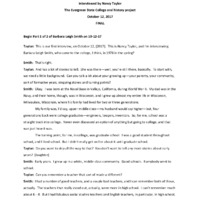Barbara Smith Oral History Interview
Item
- Identifier
- Title
- Date
- Creator
- Contributor
-
SmithBarbara
-
Barbara Smith Oral History Interview
-
October 12, 2017
-
Barbara Smith
-
Nancy Taylor
Position: 240 (20 views)

